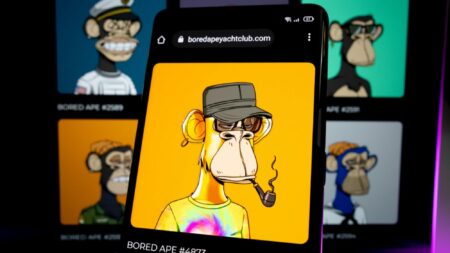The trend of people stealing art pieces and selling them as NFTs sadly continues. This is what recently happened to digital concept artist, RJ Palmer. Palmer explained on Twitter that he had to file 29 reports in a single day due to his art getting stolen and sold as NFTs.

Stolen Art Is Sign That NFT Space Still Has To Mature
People often refer to NFTS and Web3 in general as “The Wild West”. This is due to the fact that the space is still so early in its development. A major downside of that, is that it makes it easier for hackers, scammers and other bad actors to operate. It is this sense of semi-lawlessness that brings comparisons to the Wild West.
Not to mention that this downside is a natural feature of decentralization. On one hand, decentralization aims to makes it harder to censor and control people. But the other side of that coin is that regulating and policing a decentralized space is hard to do.

The Nature Of NFTs Makes Digital Art Theft Difficult To Tackle
There is a cruel irony at the heart of this negative trend. That is to say, the process allowing some artists to profit in ways they couldn’t have before, is the same one prompting certain people to exploit artists’ work.
To explain, selling tokens connected to image files is specifically what the blockchain allows artists to do. Without the provenance that it provides, people would have been very unlikely to ever purchase solely digital art. As a matter of fact, the blockchain is the specific aspect of NFTs that counters the “right-click, save” argument against NFTs.
Unfortunately, the ability to sell digital art as NFTs also creates an incentive for people to steal images – one that did not exist in this way before. Of course, this is because of how new NFTs are, whereas digital artists have been making art for decades. Thus digital artists obviously had to find other ways to profit from their work.
Palmer, for example, sells his art as physical items like prints, posters, cards and pins on his website. Indeed, selling physical items has long been one of the best ways for digital artists and photographers to receive pay for their art.

Trend Likely To Harm NFT Space If Left Unchecked
To be sure, people selling stolen or fake art is not unique to NFTs. To the contrary, it is commonly said that around half of the art in museums and that art market as a whole are fakes. Though the real number might be impossible to know, the wider point stands.
While this may be true, NFTs pose a big problem for some artists. After all, it isn’t hard for a tech savvy person to use bots to rip art from the internet, and then sell those images as NFTs. At least, it’s certainly easier than mass producing and selling fake physical items from those same artists.
Naturally, this has put some artists firmly in the anti-NFT camp. And considering that many of them first come into contact with NFTs on account of their art being stolen, it’s hard to blame them. As shown above, artist Trevor Henderson also recently had his art stolen. It’s enough to have him vow to never do NFTs. He even has “No NFTs!” in his twitter bio.
All things considered, the NFT community needs to come up with solutions to this problem. Otherwise it is likely that more artists and their supporters will reject NFTs, maybe for good.
All investment/financial opinions expressed by NFTevening.com are not recommendations.
This article is educational material.
As always, make your own research prior to making any kind of investment.








